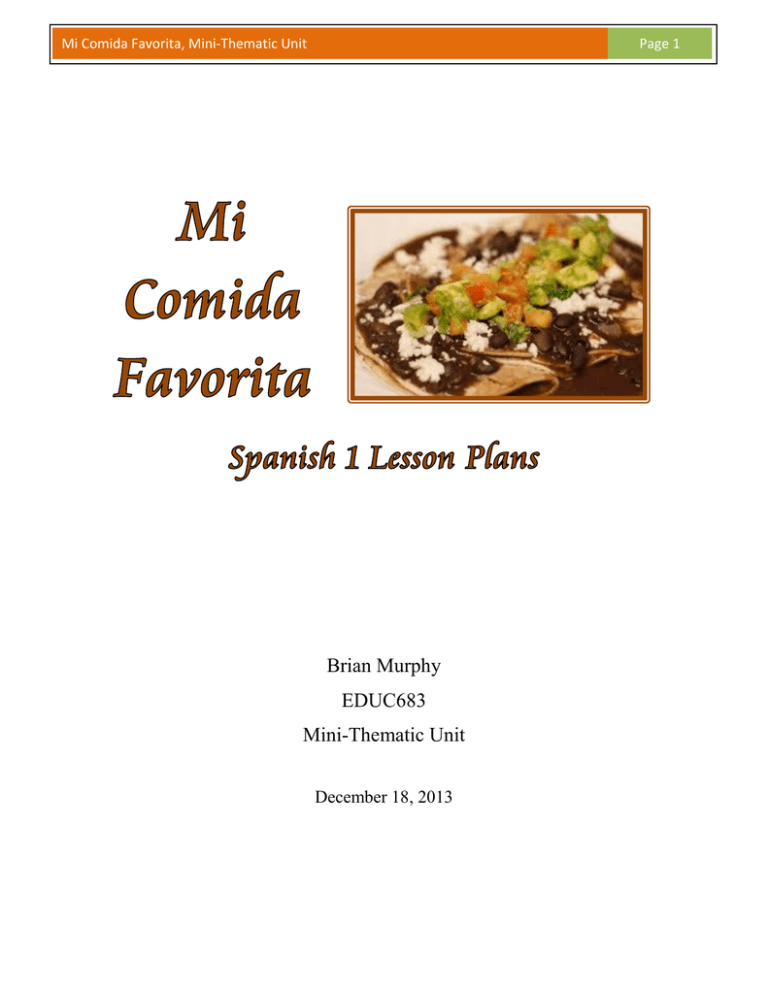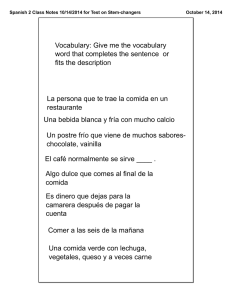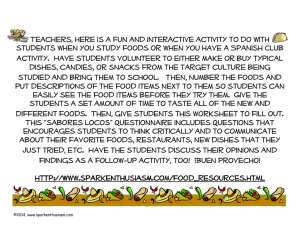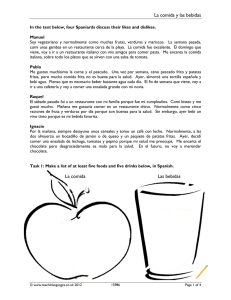Mi Comida Favorita, Mini-Thematic Unit
Anuncio

Mi Comida Favorita, Mini-Thematic Unit Page 1 Brian Murphy EDUC683 Mini-Thematic Unit December 18, 2013 Mi Comida Favorita, Mini-Thematic Unit Page 2 Table of Contents Background Information ......................................................................................................3 Setting ............................................................................................................................3 Rationale ........................................................................................................................3 Standards ........................................................................................................................4 Day 1 ....................................................................................................................................5 Lesson Plan ....................................................................................................................5 PowerPoint .....................................................................................................................8 Worksheet ......................................................................................................................9 Day 2 ..................................................................................................................................10 Lesson Plan ..................................................................................................................10 Day 3 ..................................................................................................................................13 Lesson Plan ..................................................................................................................13 Summative Assessment Rubric....................................................................................16 Appendix 1 – Food Pictures for Vocabulary Activities .....................................................18 Appendix 2 – Sample Summative Assessment ..................................................................20 Appendix 3 – Day 4 Guest Speakers Worksheet ...............................................................21 Appendix 4 – Lesson Pages from Textbook ......................................................................22 References ..........................................................................................................................27 Mi Comida Favorita, Mini-Thematic Unit Page 3 Background Information Setting Mi comida favorita is the third section of the Spanish 1 textbook “¡Avancemos!” (Carlin, Gahala, Heining-Boynton, Mondloch, & Otheguy, 2013, pages 140-147). The unit would be presented about the ninth week of first year Spanish. The students participating in these lessons are beginning Spanish speakers with little to no prior Spanish instruction. The classroom is made up of ninth graders at Osseo Junior High School. This school is approximately 80% white, 15% African American, 3% Hispanic, and 2% other ethnic backgrounds. The median family income within the school district is $75,000. This unit is based on a nine day unit covering basic foods and food related vocabulary. This unit also covers the conjugation of present tense verbs ending in –er and –ir. Prior to this unit the students have learned the verb gustar (like), which will be reviewed in this unit. The lesson plans contained in this document are for the first three lessons of the unit. A full list of lesson topics for this unit includes, by lesson: 1. Food vocabulary and introduction to Latin American foods. 2. Question words and asking/answering questions related to food. Introduce additional food vocabulary. 3. Meal vocabulary and additional culture content. Introduce summative assessment (see appendix 2). 4. Guest speakers from Mexico and Chile who will present food and meal traditions of their countries (see appendix 3). 5. Introduce final food vocabulary. Practice vocabulary and grammar in context. 6. Introduction to present tense of –er and –ir verbs. Additional culture content. 7. Practice –er and –ir verbs in context. Additional culture content. 8. The market culture content. This class would include the current unit’s vocabulary and grammar in context. 9. Present and turn in summative assessment. If time does not permit all students to present their work, then the follow day will start with those presentations Rationale Since teaching Spanish is totally new to me, I wanted to start out with a basic lesson. For this reason I chose a unit from Spanish 1. Teaching foods will provide the students with additional vocabulary and increase their communicative input and output skills. Also, the final project combines both the language and culture parts of the unit. In the final project, the students will need to identify certain foods and dishes by country. This will also increase their knowledge and understanding of Latin America. Mi Comida Favorita, Mini-Thematic Unit Page 4 Standards 1.1 Students will engage in conversations. 1.2 Students will understand and interpret written and spoken language. 1.3 Students will convey information, concepts, and ideas to listeners and readers. 2.1 Students will demonstrate an understanding of the relationships between the perspectives and practices of cultures studied. 3.2 Students will acquire information and perspectives through use of authentic materials. 4.1 Students will recognize that different languages use different patterns to communicate and can apply this knowledge to their own language. 4.2 Students will recognize that different languages use different patterns of interaction and can apply this knowledge to their own culture. Mi Comida Favorita, Mini-Thematic Unit Page 5 Day 1 Lesson Plan Lesson Plan – Food Unit, Day 1 Name: Brian Murphy Grade/Proficiency Level(s): 9th grade, level 1 Subject Area / Topic: Food Duration of Lesson: 55 minutes Essential Question What are the names of the basic foods used in the U.S. and Spanish speaking countries? What do I enjoy eating? Content/Culture Objectives: SWBAT Assessment Understand what some of the traditional foods After watching the video answer questions from of Mexico are. students. As this is an introductory piece to the culture portion of the unit, there will not be any detailed assessments. Language Objectives: SWBAT Assessment Ask and reply to questions that require an Observe students during class and group indirect object pronoun. practice. Speak and write names of various foods. Worksheet that will be done in class (attached). Explain what foods he/she likes and dislikes. Key vocabulary and concepts Exit ticket Lesson Materials and Sources (visuals, props, videos, etc.) PowerPoint video using indirect object pronouns with gustar and interesar New vocabulary: Common foods: pan, huevo, jugo, uva, leche, sopa, manzana, and platano. Recycled vocabulary from previous lessons: comer, tomar, feliz, gustar, interesar, and colors Grammar (review and use with new verbs): Use indirect object pronouns; me, te, le, les, and nos appropriately with gustar and interesar. Pictures of foods to be used in TPRS exercise (appendix 1). Worksheet (attached). Mi Comida Favorita, Mini-Thematic Unit Page 6 Accommodations Use a variety of skill levels during the TPR circling dialogue. Draw in students who are not actively engaged in activities, monitor their understanding. If there are students who are still struggling with vocabulary or grammar at the end of class allow them to take the worksheet home and review it with their parents. Procedures : Time frame Pre-Activities/Warm up in target language 3 min Ask students questions using recycled vocabulary from previous unit (i.e. ¿Qué color es tu camisa, ¿Está feliz hoy?). 8 min Review indirect object pronouns with gustar and interesar (taught in previous unit) using the PowerPoint presentation shown below. During the presentation have students repeat the questions and answers on the screen. Model the questions and answers through gestures. 8 min Using the day 1 vocabulary pictures included in the appendix, introduce the foods that will be covered in this lesson: pan, huevo, jugo, uva, leche, sopa, manzana, and platano. Have the class repeat names while the pictures are being shown. Model the statements “me gusta …..,” no me gustan …..,” “te gusta …..,” “no me interesa….,” and “nos interesa comer ….” Time frame During-Activities 15 min Activity 1: TPR - Circling Using the pan, huevo, jugo, uva, leche, sopa, manzana, and platano pictures as props, have a TPR circling dialogue. Introduction of the foods should be staggered. Questions and answers should include indirect object pronouns with the verbs gustar and interesar. Conversation should also include the recycled vocabulary listed above and words used in the warm up activity. Other verbs will be used, such as tener, estar… Pictures of the foods are to be passed around the class according to the conversation. Example conversation would include: ¿Te gusta la leche? Sí, me gusta la leche (give student the milk picture). ¿Le interesan a [class mate] las uvas? No, no le interesan las uvas. ¿Tienes los huevos? No, no tengo los huevos (give student the egg picture). ¿Dónde está la manzana? Yo tengo la manzana (student with the apple picture holds it up. ¿Tengo el platano (teacher shows that he has the banana picture)? Sí, tiene el platano. Mi Comida Favorita, Mini-Thematic Unit 8 min Page 7 Activity 2: Complete Worksheet Provide each student with a copy of the attached worksheet. They are to complete the worksheet on their own. Once worksheets are completed, they will join a partner and review their answers. As a class, answers are reviewed to ensure accuracy. Time frame 12 min Post-Activities/Wind-down 1 min Remind students to study vocabulary as it will be needed for their summative assessment that will be introduced in tomorrow’s lesson. Introduce video about Mexican cuisine by asking students what they know authentic Mexican food. Show “The Traditional Mexican Cuisine” video. Due to time constraint the video can be started at the 1:15 mark. This video is in preparation for the homework assignment/assessment. http://www.youtube.com/watch?v=VhZ-EKPPQkU. After video is complete ask students what impressed them, what was their most and least favorite, and if any have eaten any of the foods shown. Exit Ticket As the students leave they will tell me one food that they like, using a full sentence (i.e. Me gustan las manzanas). Mi Comida Favorita, Mini-Thematic Unit PowerPoint Page 8 Mi Comida Favorita, Mini-Thematic Unit Page 9 Worksheet Comida Nombre: __________________ Escribe la comida que corresponde con la imagen, usando el vocabulario abajo. la leche el huevo el pan la manzana el jugo la uva la sopa el plátano _____________________ _______________________ ___________________ _____________________ _____________________ _____________________ _____________________ _____________________ Contesta estas preguntas: 1. ¿Te gusta la sopa? ___________________________________ 2. ¿A quiénes les gusta comer pan? _____________________________________ 3. ¿Te importa comer las uvas? _________________________________________ 4. Traduce: Does the teacher like eggs and milk? ________________________________ Mi Comida Favorita, Mini-Thematic Unit Page 10 Day 2 Lesson Plan Lesson Plan – Food Unit, Day 2 Name: Brian Murphy Grade/Proficiency Level(s): 9th grade, level 1 Subject Area / Topic: Food Duration of Lesson: 55 minutes Essential Question What are the names of the basic foods used in the U.S. and Spanish speaking countries? How do I ask questions? Content/Culture Objectives: SWBAT Assessment N/A Language Objectives: SWBAT Assessment Speak and write names of various foods. Observe students during class and group practice. Ask questions that require a question word (how, what, which, why, and who). Respond to food related questions using current vocabulary and question words. Key vocabulary and concepts New vocabulary: Common foods: cereal, jamón, queso, sándwich, hamburguesa, café. Question words: ¿Cómo?, ¿Cuál(es)?, ¿Por qué?, ¿Qué?, ¿Quién(es)? Grammar: Use question words in conversation. Completion of exercise from textbook that will be done during the class. Lesson Materials and Sources (visuals, props, videos, etc.) Pictures of foods with current vocabulary (appendix 1). 3x5 cards with a question word written on each of them. Also cards with the present tense conjugations of estar and tener. 15 blank 3x5 cards. Two flyswatters. Accommodations Use a variety of skill levels during the TPRS dialogue and fly swatter game. Draw in students who are not actively engaged in activities, monitor their understanding. For students who are struggling, have them divide into pairs and create a deck of cards with pictures of the vocabulary words. Each student will take one card and look at the picture. They will then ask each other yes/no questions (i.e. ¿Tienes la manzana? No, no tengo la manzana to Mi Comida Favorita, Mini-Thematic Unit Page 11 determine which card the other has. They can play this game for a few minutes during class. Then they should take their deck of cards home with them and play the game with a family member. Procedures : Time frame 3 min Pre-Activities/Warm up in target language 5 min Using the pictures included in this lesson plan, introduce the foods that will be covered in this lesson: cereal, jamón, queso, sándwich, hamburguesa, and café. Have class repeat names while the pictures are being shown. Ask questions such as: ¿Es este el queso? while holding up a picture (teacher may hold up the queso or other picture) 5 min Modeling Question Words Write question words on the board to introduce them. Question words are: ¿Cómo?, ¿Cuál(es)?, ¿Por qué?, ¿Qué?, ¿Quién(es)? Have students practice the question words in context, such as: ¿Cuál es el queso?, ¿Quién tiene el cereal? During-Activities Time frame 10 min 10 min 10 min Ask students questions using vocabulary and grammar from previous day. Activity 1: Create Questions/Sentences Tape the 3x5 cards with vocabulary words on the board. Also tape the food vocabulary words on the board. Have a student come up and pick a question word and place it to the side. Another student will come up and pick the next word. Continue until a full question is created. Function words may be written in-between the cards as needed. The next student will come up and answer the question orally. This may include giving the food to someone in the room. Example questions would include: ¿Quién tiene el café? [Student’s name] tiene el café. ¿Dónde está el sándwich de queso y jamón? Está con [student’s name]. ¿Tienes la hamburguesa? ¿Le gusta el jugo de naranga? Activity 2: Flyswatter Game Divide class into two teams. Put the vocabulary pictures from both today and yesterday randomly on the board. One player from each team comes close to the board. Each has a flyswatter. The teacher will say the name of one of the foods in Spanish and each player tries to swat that picture. The winner takes the other student to his team. Game ends when all the class is on the same team. Activity 3: Textbook Exercise Individually, complete exercise 1 on page 142. In groups of three write three sentences about the people in the picture and what food they like to eat. Draw tongue depressors from the “class jar” to select students to share one of their sentences with the class. Mi Comida Favorita, Mini-Thematic Unit Time frame 10 min 2 min Page 12 Post-Activities/Wind-down Reading Time: La oruga my hambrienta, (Carle, E., 2011) Have class sit in a circle. Ask students to name some of the vocabulary words from this unit. Tell students to take note of the vocabulary words as the teacher reads the story. Every time a vocabulary word comes up the whole class is to say it out loud. Homework Assignment Have students complete exercise 3 on page 144 and exercise 9 on page 147 Mi Comida Favorita, Mini-Thematic Unit Page 13 Day 3 Lesson Plan Lesson Plan – Food Unit, Day 3 Name: Brian Murphy Grade/Proficiency Level(s): 9th grade, level 1 Subject Area / Topic: Food Duration of Lesson: 55 minutes Essential Question What are some of the similarities and differences in meals between the U.S. and Latin America? What vocabulary is used to describe meals? Content/Culture Objectives: SWBAT Assessment Understand foods that originated from Class discussion after video (to be done in English). Latin America and the importance of knowing where foods come from. Language Objectives: SWBAT Assessment Speak and write meal vocabulary. Observe students during class and group practice. Understand similarities and differences in meal traditions between the U.S. and Latin America Key vocabulary and concepts New vocabulary: Meal related words: almuerzo, bebida, cena, comida, and desayuno. Exit ticket. Lesson Materials and Sources (visuals, props, videos, etc.) Rubric for summative assessment (attached). Culture: Latin American meal time Accommodations Use a variety of skill levels during the TPRS dialogue and fly swatter game. Draw in students who are not actively engaged in activities, monitor their understanding Mi Comida Favorita, Mini-Thematic Unit Page 14 Procedures : Time frame 5 min 5 min Time frame 10 min 15 min 15 min Pre-Activities/Warm up in target language Review homework assigned previous day. Have students roam through the classroom to ask and respond to the homework questions. For each question that a student gives, the partner is to initial that question. For each reply given, the asking partner initials the response. All questions and answers should be initialed by different people. Modeling Meal Vocabulary Teacher role-plays almuerzo, bebida, cena, comida, and desayuno by acting out events for each setting. For example; get out of bed, stretch then have some cereal. Say what he is doing at each step, for example, “estoy comiendo cereal para mi desayuno.” During-Activities Activity 1: Complete Modeling Activity Have three students stand in front of the class. Each is assigned a meal (desayuno, almuerzo, and cena). The teacher starts by asking questions regarding their roles. Once the students become comfortable with their roles have students ask the questions. Also the three up front can ask questions to the class. Example questions would include: ¿Quién come almuerzo? ¿Qué come [student’s name] para cena? ¿Toma una bebida [student’s name] con su desayuno? ¿Como hamburguesas para desayuno? Activity 2: Scrambled Eggs (Curtain & Dahlberg, 2010, pg 382) Have the class sit in two circles. Two students will stand in the middle of each circle and will have the following conversation: Student 1: Hola, me llamo _______. Me gusta(n) _________ para _________ . ¿Qué te gusta(n) ____________ para ___________ ? Student 2: Me gusta(n) _____________ para ___________. Student 1 then sits in student 2’s seat. Student 2 becomes the new student 1. Student 2 then selects someone to be the new student 2. Game continues until everyone is in a different seat. Activity 3: Foods originating from Latin America Pre video – Discuss what foods the students think originated in Latin America, where they originated, and how long ago. Ask students to take note of two things that impressed them during the video. Mi Comida Favorita, Mini-Thematic Unit Time frame 4 min 2 min Page 15 Show the video “Latin American Food Culture.” http://www.youtube.com/watch?v=o9FOjFwmMQc. Once completed, have the students get in groups of 4-5 and discuss what impressed them. Rearrange the groups and repeat. Post-Activities/Wind-down Show an example and explain the unit’s summative assessment. Hand out rubric and review it with the class. Exit Ticket Have each student write one thing they learned from the video and hand it to the teacher as they leave. Mi Comida Favorita, Mini-Thematic Unit Page 16 Summative Assessment Rubric ______________________________________________________________________________ Mi Comida Favorita Unit Project For the unit on food, each student will make a poster demonstrating their knowledge of Latin American foods and typical dishes. On the last day of the unit, students will give a two minute presentation to support their poster. The poster is to include: 1. A map of Latin America. 2. A main agricultural crop (plant or livestock) is identified for each of five countries. There is to be legend or table listing these countries and their crop. Also a marker (i.e. picture or label) is placed with each of the five countries to identify the country and what product is represented. 3. For each of five countries (may be the same as above or different), a typical dish is identified. There is to be legend or table listing these countries and their dish. Also a marker (i.e. picture or label) is placed with each of the five countries to identify the country and what dish is represented. 4. The poster will be graded on completeness and accuracy of the contents listed above and the quality of the work. The presentation is to include: 1. Identifying all ten items shown on the poster (five agricultural and five dishes). 2. Facts about four of those items, either agricultural and/or dishes are to be discussed. These may be the contents of a dish, history of a dish, when a crop was domesticized (used in farming), amount of a crop that is exported. 3. Total length of the presentation is 1:30-2:00. 4. The presentation will be graded on completeness of points mentioned above, length of the presentation, and speaking (clear, understandable). The attached rubric provides additional grading information. There are 20 points possible for this assignment. We will have limited time in class to work on the posters, so you will need to plan on spending time at home on this assignment. Both the poster and presentation are to be done individually. The poster is to be in Spanish, the presentation can be done in English. Mi Comida Favorita, Mini-Thematic Unit Page 17 Mi Comida Favorita Unit Project – Grading Rubric Grading for your unit poster and presentation will be based on the chart below. CATEGORY 4 Points 3 Points 2 Points 1 Point Poster Completeness Poster accurately places all agricultural and typical meal items = 10 total items. Poster accurately places some agricultural and typical meal items = 8-9 total items. Poster accurately places some agricultural and typical meal items = 7-8 total items. Poster accurately places some agricultural and typical meal items = 6 or less total items. Poster Presentation Poster is completed neatly with proper locations for all required items. Poster is completed neatly with proper locations for 9099% required items. Poster is not completed neatly and/or proper locations 80-90% of the required items. Poster is not completed neatly and/or proper locations for less than 80% of the required items. Presentation Time-Limit Presentation is Presentation is Presentation is 1:30-2:00 minutes 1:00-1:30 minutes 0:30-1:00 minute long. long. long. Presentation Speaking Speaks clearly and Speaks clearly and Speaks clearly and Often mumbles or distinctly all (95- distinctly all (90- distinctly most cannot be 100%) the time. 94%) the time. (80-89%) of the understood. time. Presentation Content Mentions all ten items with a fact about four of them. Total items and facts mentioned = 14. Mentions some items with facts. Total items and facts mentioned = 11-13. Mentions some items with facts. Total items and facts mentioned = 8-10. Presentation is less than 30 seconds OR more than 2 minutes. Mentions some items with facts. Total items and facts mentioned = 7 or less. Mi Comida Favorita, Mini-Thematic Unit Appendix 1 – Food Pictures for Vocabulary Activities Day 1 Vocabulary Day 2 Vocabulary Page 18 Mi Comida Favorita, Mini-Thematic Unit Day 5 Vocabulary Page 19 Mi Comida Favorita, Mini-Thematic Unit Page 20 Appendix 2 – Sample Summative Assessment País México Costa Rica Columbia Chile Argentina Producto Importante Maíz Plátanos Café Uvas Vacas País Guatemala Panamá Ecuador Paraguay Bolivia Comida Típica Chiles rellenos Bollos Ceviche Pira caldo Salteña Mi Comida Favorita, Mini-Thematic Unit Page 21 Appendix 3 – Day 4 Guest Speakers Worksheet Comida Típica de México y Chile Martha Rendón Comida de México Liliana Aguilera Comida de Chile What are three of the main foods that people from each of these countries eat? Describe one aspect of Mexican food and/or meal time traditions that interested you. Describe one aspect of Chilean food and/or meal time traditions that interested you. What else stood out to you from Martha Rendón’s presentation? What else stood out to you from Liliana Aguilera’s presentation? Mi Comida Favorita, Mini-Thematic Unit Appendix 4 – Lesson Pages from Textbook Page 22 Mi Comida Favorita, Mini-Thematic Unit Page 23 Mi Comida Favorita, Mini-Thematic Unit Page 24 Mi Comida Favorita, Mini-Thematic Unit Page 25 Mi Comida Favorita, Mini-Thematic Unit Page 26 Mi Comida Favorita, Mini-Thematic Unit Page 27 References Carle, E. (2011) La oruga muy hambrienta. New York, NY: Philomel Publishing Company Carlin, P. Gahala, E. Heining-Boynton, A. Mondloch, B. & Otheguy, R. (2013) ¡Avancemos! (1st ed.). Orlando, FL: Houghton Mifflin Harcourt Publishing Company. Curtain, H. & Dahlberg C. (2010) Languages and Children (4th ed.). Boston, MA: Pearson Education, Inc. Latin American Food Culture. http://www.youtube.com/watch?v=o9FOjFwmMQc (Retrieved December 16, 2013) The Traditional Mexican Cuisine http://www.youtube.com/watch?v=VhZ-EKPPQkU (Retrieved December 17, 2013)



